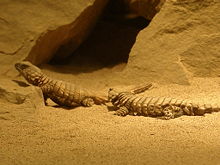- Armadillo Lizard
-
Armadillo Lizard 
Conservation status Scientific classification Kingdom: Animalia Phylum: Chordata Class: Reptilia Order: Squamata Suborder: Sauria Family: Cordylidae Genus: Cordylus Species: C. cataphractus Binomial name Cordylus cataphractus Synonyms Cordylus nebulosus
The Armadillo Lizard (Cordylus cataphractus) is a lizard endemic to desert areas of southern Africa. It is also known as the Typical Girdled Lizard, Armadillo Girdled Lizard, Golden Armadillo Lizard, and Armadillo Spiny-tailed Lizard.
Contents
Description
The Armadillo Lizard can be a light brown to dark brown in coloration depending on the subspecies. The underbelly is yellow with a blackish pattern, especially under the chin. Its size ranges from 16 to 21 cm (6½ to 8½ in) in length. It grows up to 10.5 centimeters snout-to-vent length.[1]
The Armadillo Lizard is a relatively common lizard in the pet trade. It can be found in pet stores and it is quite easy to breed in captivity. Wild populations are threatened by collecting for sale in the pet trade.[1][2]
Habitat and Distribution
The natural habitat of this lizard is scrub and rocky outcrops. It is diurnal. It hides in rock cracks and crevices. It lives in social groups of up to 30[1] to 60, but usually fewer.[2] Males are territorial, protecting a territory and mating with the females living there.[2] The female gives birth to one[1] or two[2] live young; the species is one of the few lizards that does not lay eggs. The female may even feed her young, which is also unusual for a lizard.
Diet
The Armadillo Lizard lives mainly on small invertebrates such as insects and spiders. In the wild its most common prey items are the termites Microhodotermes viator[1] and Hodotermes mossambicus.[2] It can live up to 25 years in captivity, or slightly more in rarer cases.
The Armadillo Lizard possesses an uncommon antipredator adaptation, in which it takes its tail in its mouth and rolls into a ball when frightened. In this shape it is protected from predators by the thick, squarish scales along its back and the spines on its tail.[1] This behavior, which resembles that of the mammalian armadillo, gives it its English common name.[1] This behavior may have inspired the mythical creature Ouroboros.
Soures
References
Extant Cordylidae species Kingdom: Animalia · Phylum: Chordata · Class: Reptilia · Order: Squamata Chamaesaura Cordylus PlatysaurusBroadley's Flat Lizard (P. broadleyi) · Cape Flat Lizard (P. capensis) · Common Flat Lizard (P. intermedius) · Dwarf Flat Lizard (P. guttatus) · Emperor Flat Lizard (P. imperator) · Lebombo Flat Lizard (P. lebomboensis) · Mitchell's Flat Lizard (P. mitchchelli) · Ocellated Flat Lizard (P. ocellatus) · Orange throated Flat Lizard (P. monotropis) · Pungwe Flat Lizard (P. pungweensis) · Sekukhune Flat Lizard (P. orientalis) · Soutpansberg Flat Lizard (P. relictus) · Spotted Flat Lizard (P. maculatus) · Striped Flat Lizard (P. torquatus) · Waterberg Flat Lizard (P. minor)Pseudocordylus This lizard article is a stub. You can help Wikipedia by expanding it.

